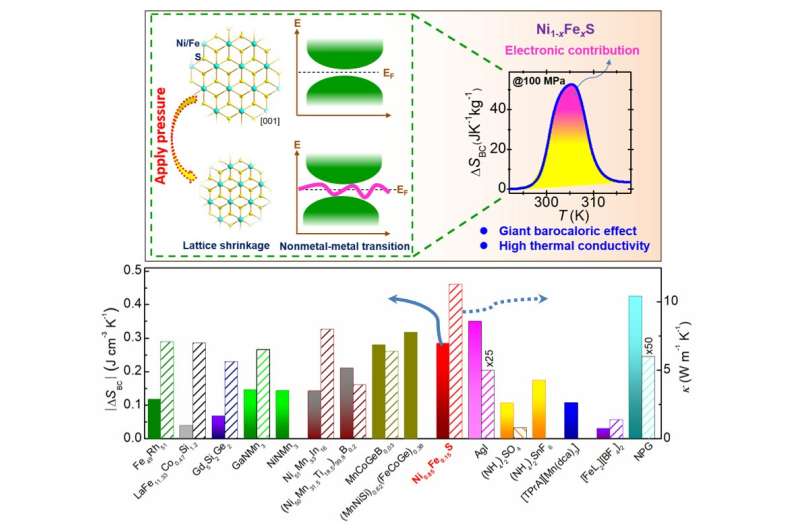A sketch map for the mechanism of giant barocaloric (BC) effect in Ni1-xFexS (up pattern). A comparison of volume normalized entropy change driven by 100 MPa and thermal conductivity (k) for Ni0.85Fe0.15S and other giant BC materials (bottom pattern). Credit: LIN Jianchao
A research team has found a new type of giant barocaloric (BC) material (hexagonal sulfides) and discovered an important role of electrons in boosting the total entropy change driven by hydrostatic pressure.
This team was led by Prof. Tong Peng from the Institute of Solid State Physics, Hefei Institutes of Physical Science, together with Prof. Li Bing from the Institute of Metal Research of the Chinese Academy of Sciences (CAS) and Prof. Zhong Guohua from the Shenzhen Institutes of Advanced Technology of CAS.
In these sulfides Ni1-xFexS, the team observed a giant entropy change at room temperature induced by pressure. For instance, an entropy change of around 50 J kg-1 K-1 and a temperature change of ~10 K can be triggered by a small pressure of 100 MPa. Such a high BC performance ranks the current sulfides among the giant BC materials.
Based on theoretical calculations and analysis of low-temperature specific heat, they demonstrated a drastic electronic structural modification and accordingly a large electronic entropy change under pressure, which remarkably facilitate the total BC effect.
More importantly, at the phase transition temperature, the thermal conductivity reached 12 W m-1 K-1, which is superior to the values of other BC materials.
It is two orders of magnitude larger that (0.12 W m-1 K-1) of neopentylglycol, which exhibits the strongest BC effect up to date. High thermal conductivity means high heat-transfer frequency, which is conducive to obtaining high operating frequency and refrigeration power density.
Therefore, the excellent BC performance along with superior thermal conductance suggests the current materials are promising refrigerant candidates for solid-state cooling.
More information: Jianchao Lin et al. Giant room-temperature barocaloric effect at the electronic phase transition in Ni1−xFexS, Materials Horizons (2020). DOI: 10.1039/C9MH01976F
Provided by Chinese Academy of Sciences
























